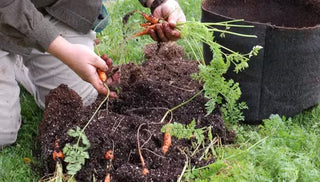What can you grow in a Gardener's Best Grow Bag? As we discovered in our test gardens, almost anything!
 Our average harvest was 3 lbs. per bag.
Our average harvest was 3 lbs. per bag.What You'll Need
on Planting Day
- Carrot seeds: We recommend a compact Nantes-type. To avoid thinning, look for pelletized seed.
- Grow Bag: The Gardener's Best Potato Grow Bag makes a good fit for a crop of carrots.
- Planting mix (potting soil): The Potato Grow Bag holds 50 quarts. We recommend our Container Mix. Do not use ordinary garden soil because it will not drain freely when used in the Grow Bag.
- Granular fertilizer: We recommend All-Purpose Fertilizer.
- Water
When we started thinking about all the vegetable crops that might benefit from the ideal growing conditions in a Grow Bag, carrots were right at the top of the list. All vegetables grow better in good soil, but there are some crops that demand it. Carrots, being a root crop, simply won't develop properly in heavy clay or stony soils. For best appearance and a sweet flavor, they need soil that's friable, well-drained, neutral to alkaline, and not too rich in nitrogen. Grow Bags are a good option for urban gardeners, who often have little space but plenty of sun.
In our tests, we planted several crops of carrots in Grow Bags similar to our Potato Grow Bags. All the bags were filled with pre-moistened Container Mix, to which we added All-Purpose Fertilizer and Container Booster Mix. A few cups of compost could be substituted for the Booster Mix.
For seeds we recommend compact varieties, such as Nantes, which has sturdy, sausage-shaped roots. Nantes are known for their crispness and excellent flavor. They have a smooth exterior and are somewhat shorter than traditional varieties with pointy ends.
All carrots are frost-hardy, so don't be afraid to plant them early — as much as a month before your last frost date. Not sure of frost dates in your area? Contact your local cooperative extension service. For a continuous harvest, you can plant several Grow Bags, one each month until midsummer.
How to Plant the Grow Bag
Pick the site: Select the sunniest site possible. All-day sun is best, but as little as 6 to 8 hours will do. Keep in mind that you will need to water the Grow Bag regularly, especially if rainfall is insufficient.
Prepare the planting mix: Put the potting mix in a wheelbarrow or tub that can hold it all at once. Moisten it thoroughly. Mix in granular fertilizer and Container Booster Mix, according to the rate recommended on the package. Fill the Grow Bag with the moistened planting mix, saving a few handfuls to cover the seeds.
 The crop of carrots during the summer.
The crop of carrots during the summer.Sow the seeds: Scatter seeds on the soil surface so they are about 3" apart and cover them with about 1/4" of planting mix. Water thoroughly. Carrots, like beets, have a hard seed coat. For good germination and strong early growth, the seeds must be kept consistently moist ? not wet ? for the first two or three weeks. Cover the top of the Grow Bag with a layer of garden fabric to retain moisture or plan on watering more frequently. Once the plants are established, water deeply, as needed, checking soil moisture levels with your finger.
Thin out the seedlings: To get a crop of good-size carrots, thin out seedlings to 3" apart. You can pull them out by hand or snip the unwanted seedlings with a scissors.
Feed regularly: Add 1/4 cup of granular organic fertilizer every four to six weeks after thinning.
Our carrots were ready to harvest in about 75 days, exactly what the seed package predicted. The carrots can be harvested all at once, or you can pull them as needed. We averaged about 3 lbs. of carrots per bag. For a fall carrot crop, replant some carrots in midsummer. For good germination, sow seeds under shade net or in an area where the soil is slightly shaded and will stay cool and moist.





